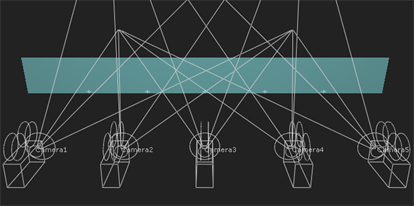

Still tracking relies on good input to produce good tracking output, so it's vital that you capture good still photographs that CameraTracker can interpret correctly.
CameraTracker has different requirements depending on the subject of the stills. For example, stills for a near-flat scenes are captured differently to those required for an interior set or model.
• Don't crop your stills or transform them in anyway, such as rotation.
• Avoid dramatic changes in scale and angle between stills.
• To ensure you capture every part of the scene in 3 to 4 images, aim for a maximum change of 20-25% in content between frames.
• Avoid unnecessary redundancy where still frames contain large portions of the previous frame.
• Avoid tracking stills containing multiple occlusions - features with complex overlap can result in drastic changes in content between frames.
The best stills for near-flat scenes are captured head-on, facing the subject. In Nuke terms, that would mean taking your stills from the camera positions shown on the right.
|
|
|
| Incorrect camera positioning. | Correct camera positioning. |
When moving around an object, a photo every 15-25 degrees should be adequate, so a minimum of 16 shots for a full 360. Of course, taking more can improve the result.
|
|
|
| Too few stills. | Minimum number of stills. |
For enclosed spaces, such as interiors, capture stills from the center facing outward and then around the perimeter facing inward, rather than from different points within the space.
|
|
| Incorrect camera positioning from different points. |
|
|
|
| Capturing stills facing outward. | Capturing stills facing inward. |